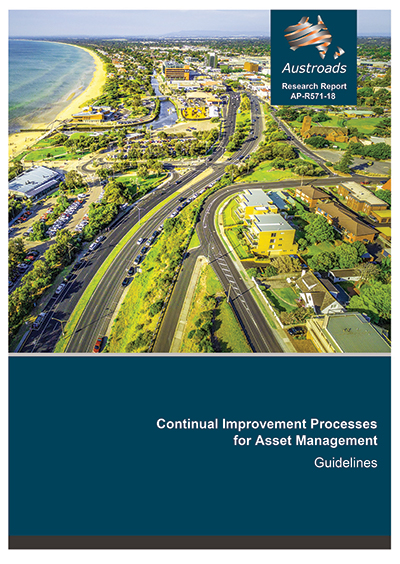Asset Management

- Publication no: AP-R571-18
- ISBN: 978-1-925671-57-5
- Published: 28 May 2018
- PDF (free) Download
This guideline has been prepared in response to the need for a more structured approach to continual improvement in asset management.
National, state and local governments in Australia and New Zealand are collectively responsible for over 900,000 kilometres of road, valued at more than $250 billion. Surveys have indicated road management organisations do not always have a structured continual improvement process that satisfies the requirements of ISO55001:2014 Asset management – Asset management – Management Systems - Requirements. Having a structured process in place has the potential to provide significant value to organisations.
The guideline aims to provide asset management practitioners with an understanding of the factors that contribute to enabling and sustaining continual improvement. The current challenges within the industry in relation to continual improvement are discussed, with a framework provided for successful implementation.
This document suggests that at the core of every successful organisation implementing continual improvement, is a supportive and enabling environment. Once this environment is achieved, continual improvement will become second nature.
The guideline was developed through research and extensive engagement with around 80 industry professionals.
- Summary
- 1. What is Continual Improvement?
- 1.1 Purpose of this guideline
- 1.2 Key messages in this guideline
- 1.3 Continual improvement process within the asset management system
- 1.4 Linkage with other Austroads asset management guidelines and projects
- 1.5 Challenges facing the asset manager in continual improvement
- 2. Justifying Continual Improvement
- 2.1 The benefit of continual improvement in asset management
- 2.2 Writing the continual improvement business case
- 2.2.1 Considerations
- 2.3 Case Studies
- 3. Incorporating Continual Improvement into Existing Management Processes
- 4. A Framework for Continual Improvement
- 4.1 Creating the environment for continual improvement
- 4.1.1 Leadership
- 4.1.2 Culture
- 4.1.3 Governance
- 4.1.4 Knowledge management
- 4.1.5 Support and resources
- 4.2 Identify continual improvement opportunities
- 4.2.1 Improvement Register
- 4.3 Evaluate and prioritise improvement proposals
- 4.4 Implement continual improvement initiatives
- 4.5 Monitor the results of the initiative
- 4.6 Document the continual improvement process
- 4.1 Creating the environment for continual improvement
- 5. Techniques for Continual Improvement
- 6. Case Studies
- References
- Appendix A Continual Improvement Techniques and Tools
- A.1 Continual improvement techniques
- A.2 Supporting continual improvement tools
- Appendix B Case Studies/Round Table Information and Suggestions
- B.1 Benchmarking
- B.2 Collaboration
- B.3 Customers
- B.4 Decision framework
- B.5 Governance
- B.6 Information
- B.7 Lessons learnt
- B.8 Process
- B.9 Value
- Appendix C Sample Business Case
